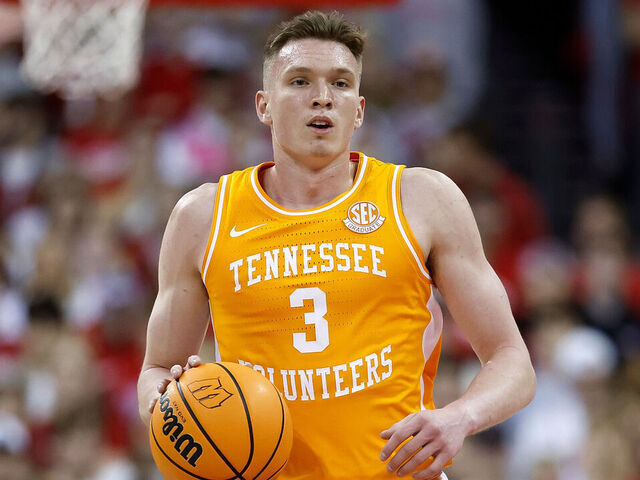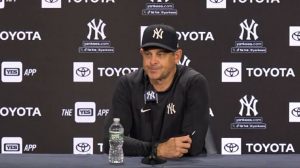
ESPN Confirm Trade: Successful Deal Volunteers Coach Set To Welcome A Top Player That Is Better Than Dalton Knecht…
The best weekend of the men’s college basketball regular season — maybe the best weekend of the past several regular seasons — is upon us, with four matchups between top-10 teams highlighting the schedule.
No. 4 Houston travels to No. 8 Kansas in the biggest test of the Cougars’ young Big 12 career (Saturday, 4 p.m. ET, ESPN); No. 7 Duke takes the short drive to No. 3 North Carolina for the 49th top-10 meeting between the two teams (Saturday, 6:30 p.m. ET, ESPN); No. 5 Tennessee is in a bounce-back situation at No. 10 Kentucky (Saturday, 8:30 p.m. ET, ESPN); and No. 6 Wisconsin looks for a marquee win when it hosts No. 2 Purdue (Sunday, 1 p.m. ET, CBS).
(If only the Big East could have scheduled one of the two meetings between No. 1 UConn and No. 9 Marquette for this weekend!)
Interestingly enough, the schedule calls for rematches of all four of these games on the final weekend of the regular season — though the teams might not all be in the top 10 by that point. So, this weekend gets the edge as “the best college basketball weekend ever” for now.
This weekend also means the top of the AP poll will look very different come Monday, depending on the outcomes of these four games. So where will each of these games be won? Which teams have the advantage at either end of the floor? We reached out to opposing coaches who have played each team to break down the keys to the games.
Houston’s biggest edge: While the Cougars’ defense gets most of the credit for their consistent success in recent years, opposing coaches pointed to their offensive rebounding as potentially the biggest factor on Saturday. They rank No. 6 nationally in offensive rebounding percentage — and No. 1 in Big 12 play — and they’ve ranked in the top five in that category in each of the past four years.
On the other side, Kansas ranks in the middle of the league in defensive rebounding and really struggled on the glass against West Virginia and Cincinnati.
“[Houston’s] rebounding is relentless. It cannot be simulated,” one coach said. “It happens so fast. They’re trying to make the shot obviously, but their best offense is sometimes, ‘just throw the ball up there and go get it.’
“You can say whatever you want, box out, be physical, anticipate, but it’s unmatched. There are other teams that do it, but it’s the physicality of how it happens. They’re so physical on offense. They wear you down. They’ve got big bodies and everyone besides [L.J.] Cryer is going in there and crashing relentlessly. Multiple efforts, swim moves — it just becomes hard to sustain being able to keep them off the glass.”
Of course, we’d be remiss if we didn’t talk about Houston’s defense, which is tracking to be one of the best defenses since 1999, according to KenPom. Texas was the first team all season to score 70 points against Kelvin Sampson’s team — and needed overtime to get there. The Cougars rank first nationally in adjusted defensive efficiency, effective field goal percentage defense, 2-point percentage defense and block percentage, while also finding spots in the top 10 in turnover percentage and 3-point defense.
“[Jamal] Shead at the point of it, he controls the whole tempo of the game,” a Big 12 coach said. “They do a great job of disrupting you in the scoring areas, pushing you off one more spot, contesting all shots. They do a good job on the defensive rebounding end. There’s not a lot of second shots against them. You watch them, Iowa State-Houston was like a football game. They do a great job of being physical. They disrupt you with their physicality.
Kansas’ biggest edge: When the Jayhawks play at home, it’s obvious: The home-court advantage. It’s arguably the best in the country, and Kansas hasn’t lost at Allen Fieldhouse all season.
“If you’re not up by double figures with two minutes to go, a minute and a half to go, you’re going to lose,” an opposing coach said. “They find a way. They make a shot, someone makes a right-hand drive, [Bill Self] draws up a play to get a 3. Teams have played close games there, had leads with a couple minutes left. You start thinking, ‘We got this one.’ No you don’t. It’s just something they do.”
The emergence of Johnny Furphy over the past few weeks has eliminated one of Kansas’ weaknesses, which was a lack of a consistent player outside its big four veterans. The freshman from Australia has started the past six games and scored in double figures every time he has played 20 or more minutes this season. He’s averaging 15.4 points, 7.4 rebounds and shooting 43.9% from 3 in his past five games.
“He’s every bit of 6-foot-8 if not taller, he’s athletic vertically and he makes shots,” a coach said. “He spaces the floor. He changes things, it’s different from when they had [Elmarko] Jackson in the lineup. It changes everything. It gives [Hunter] Dickinson more space, they’re going to be able to run their lob play, get easy touches, Furphy is on the backside. He allows them to space the floor and he’s a threat in transition.”
Where the game will be won: There are two huge keys to Saturday’s game. First, the availability of Kevin McCullar Jr. The versatile senior is enjoying a true breakout campaign, averaging 19.8 points, 6.4 rebounds and 4.7 assists, but he missed Kansas’ win over Oklahoma State on Tuesday with a bone bruise. Self said after the game his status for Saturday was unclear.
“His jump shot has improved. He was at 40% from 3 for most of the season. Him being able to knock down that shot consistently, it changes how you have to guard them,” one coach said. “He’s taken his game to another level. Running off screens, running misdirections. Lob play, back-cut play.”
But even more important to watch might be the aforementioned rebounding battle at Kansas’ defensive end of the floor. While Houston can be dominant at that aspect of its game, the Jayhawks’ ability to grab defensive rebounds and get out in transition has been a huge part of their offensive success for much of Self’s tenure. If Houston can get second-chance opportunities, advantage Cougars. If Kansas can hold its own on the glass and push the ball against an unsettled Houston defense, advantage Jayhawks.
According to CBB Analytics, Kansas ranks third in the league in fast-break points per game, while Houston is first in limiting fast-break points.
“You can make an emphasis to go to the glass on Kansas. The thing with them, though, is you have to go and get it, because if they get it, it’s going down your throat,” one coach said. “You have to be judicious in how you go about it. Houston will do what they do. But Kansas’ transition offense is elite. It’s hard to simulate their transition. Can they hold Houston to one shot?”
Duke’s biggest edge: The most intriguing stylistic battle on Saturday will be between Duke’s 3-point shooting and North Carolina’s 3-point shooting defense. The Blue Devils rank first in the ACC in 3-point shooting in league play, making better than 40% of their outside jumpers, while Carolina is first in the league in 3-point percentage defense, limiting ACC opponents to below 27% from behind the arc.
“Duke is the better shooting team,” an ACC coach said. “North Carolina has to limit Duke’s transition 3s and force them to play in the half court. That’s where they’ll have a better chance of guarding them. Those broken plays, where the court is unbalanced, that’s where they get their 3s, transition 3s. They typically have four guys on the court that can really, really shoot it, around 40% or higher. Their perimeter as a collective is just a better shooting group.”
Duke appears to be fully healthy entering the game, which is good news considering Jeremy Roach, Tyrese Proctor and Mark Mitchell have all missed time at various points this season. Proctor, in particular, has really begun to hit his stride after missing three games with a sprained ankle. He’s averaging 16.4 points and shooting 48.4% from 3 over the past five games.
“I think [Jared] McCain is the best shooter in the ACC,” one coach said. “If he shoots it, it’s going in. Roach is shooting it at a high clip when he’s open. Proctor is good for them because he’s balancing the decision-making; now he’s hitting shots, he’s adding something as a scorer.”
Mitchell was the focal point of opposing scouting reports earlier this season, as Arizona, Arkansas and Georgia Tech all essentially left him alone on the offensive end and let him shoot, while focusing on the other four players on the floor. It worked to different extents for all three teams. But the 6-9 forward has been playing better over the past six weeks, including putting up three 20-point performances in ACC play.
“If you really look at Duke’s team, they don’t really have any wings,” one coach said. “Mitchell is the biggest, best athlete. When he uses his athleticism at both ends of the floor, slashing, cutting, driving to the rim, he gives them that dimension they don’t really have otherwise. People try to force him to be a shooter, but he’s found a way to impact the game with slashing, scoring around the basket, finishing around the basket.”





